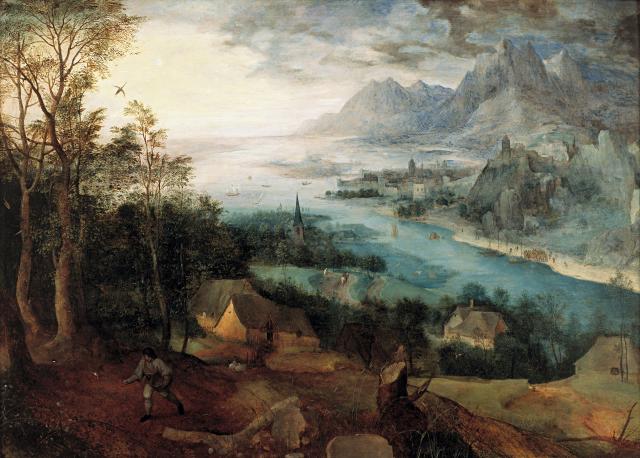In the left foreground, a peasant scatters seed on a small upland pasture. In accordance with the text from Matthew (13:3-13), fowl are devouring the seed, thorns are flourishing, and there are stony places. Below to the right and in the middle distance near a chapel is the "good ground," where the seed has multiplied, thirty-, sixty-, and a hundredfold. A river flows diagonally from the right middle distance into a broad estuary. Three small boats are moored on the right bank of the river. Near the first one, a small crowd gathers to hear jesus preaching. Further along on the right bank is a small fortified town on a hill; below, a little to the left, is a larger town dwarfed by Alpine crags.
The picture first came to notice when it was bought by Fernand Stuyck at public auction at the Fievez Gallery, Brussels, in 1924. It was then catalogued simply as Flemish school, seventeenth century. In December of that year; when it was cleaned by the elder Mr. Buesco, conservator for the Belgian royal family, the signature Brueghel and the date 1557 were revealed. The painting came to the United States just before World War II. It was then shown in San Francisco and Washington, D.C. Two known replicas of the painting exist, both attributed to Bruegel. One was owned in 1932 by Cloots, the director of the Gallery Alice Marteau, Paris; the other is in the Prado, Madrid (no. 1964).
Friedlander (1937) considered this panel one of Bruegel's earliest signed paintings, done shortly after his designs for Cock in Antwerp. The drawings upon which the designs were based were made by Bruegel as he crossed over the Alps on his return from Italy. They reveal the impact on the Northern artist of both the heroic spirit of the Renaissance with which he became acquainted in Rome and the austere grandeur of the magnificent mountains. His Northern eyes, with their inherited inclination toward detail and exactitude, looked with awe upon the scenes, which his genius, broadened by his Italian experience, recorded in a series of drawings unique in their breadth and detail. From them came the etched landscapes that were published in Antwerp in 1555-57. A careful comparison of the Putnam picture with details in Bruegel's etched landscapes is revealing. Fortified hill towns situated on similar steep rocky bluffs are to be found in the Plaustrum Belgicum, the Euntes in Emmaus, and the Penitent Magdalen (Engraving, New York, The Metropolitan Museum of Art, Harris Brisbane Dick Fund, 192.6, 26.72.53).
The aerial perspective of the painting, the sentiment of landscape, and the manner in which it is composed all confirm the early date inscribed on the panel, a date before Bruegel's departure for Brussels. The subject matter is Bruegel's earliest treatment of the theme of a parable, a subject he took up often in later years.

